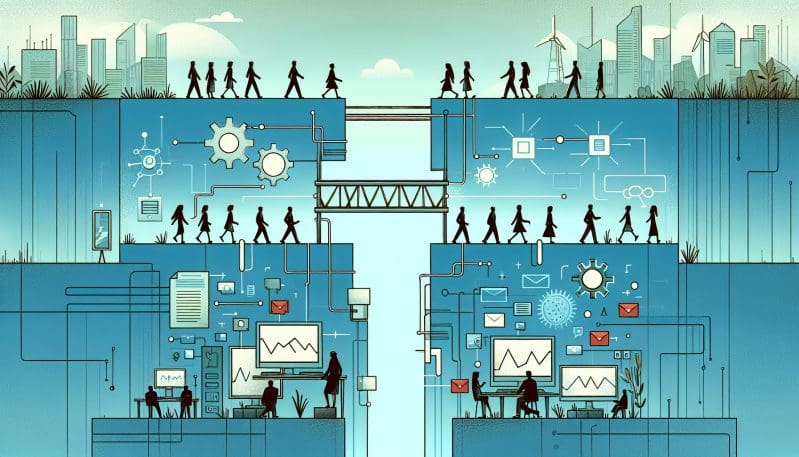The Digital Divide in Career Development: Bridging the Gap in a Post-Pandemic World
- Home
- The Digital Divide in Career Development: Bridging the Gap in a Post-Pandemic World

- Editors Desk
- February 21, 2024
- 0 Comments
The global pandemic has accelerated the shift towards a digitally-driven economy, exposing a stark digital divide in the workforce. This divide is not just about who has access to the internet—it’s about who can leverage digital tools for career advancement and who cannot. As organizations restructure and remote work becomes more common, proficiency in digital skills is increasingly synonymous with employability.
Employees familiar with digital technologies find themselves at a distinct advantage, capable of transitioning into new roles that demand such expertise. Conversely, workers with limited digital literacy—often older employees or those in traditionally non-tech industries—are finding themselves at a career crossroads, where the path forward seems increasingly obscured by the lack of digital acumen.
The impact of the digital divide on career progression is multifaceted. It influences hiring decisions, promotion opportunities, and even the ability to transition into entirely new fields. The digital divide can act as a glass ceiling, capping the potential of talented individuals who have not had the chance to develop relevant digital skills.
Companies, alongside governments, possess the resources and the responsibility to bridge this divide. Digital literacy and upskilling programs can empower employees, equipping them with the tools essential for success in a modern economy. However, implementing these programs comes with its own set of challenges. Access to technology remains a barrier, particularly for those in rural or disadvantaged communities. Additionally, motivation to learn new skills can wane, especially if workers perceive digital tools as a threat to their job security rather than an opportunity for growth.
Despite these barriers, there have been success stories. In some sectors, like manufacturing and healthcare, targeted interventions have successfully closed the digital divide. Workers have been retrained to operate advanced digital machinery, or to utilize electronic health records, demonstrating that with the right support, the transition to digital can be inclusive and beneficial for all.
‘No Worker Left Behind’ predicates itself on the belief that in the post-pandemic world, career development should not be the privilege of the few but the right of the many. This belief translates into a solution-oriented framework that promotes strategies ensuring all workers have access to the opportunities afforded by the digital economy.
Key to this approach is fostering partnerships between businesses, educational institutions, and policymakers to create comprehensive upskilling initiatives. These programs should be accessible, affordable, and relevant, cutting across demographic and sectoral lines to reach those most affected by the digital divide.
Beyond programmatic interventions, there is a need for cultural shifts within organizations. These changes encompass recognizing the value of a diverse workforce that includes digital natives and seasoned professionals alike, and understanding that the unique perspective of each group can drive innovation and growth.
Ultimately, in closing the digital divide, we are not just enhancing individual career prospects—we are building a more resilient, adaptive, and inclusive workforce that is equipped to navigate the challenges of a rapidly changing economy. ‘No Worker Left Behind’ embodies this spirit, advocating for every worker’s potential to be harnessed through the power of digital technology.
As we look to the future, it’s clear the time for action is now. By collectively addressing the digital divide, we can build a workforce that is not only prepared for tomorrow’s challenges but is also a driving force behind a more equitable, prosperous, and sustainable global economy.

Leave A Comment